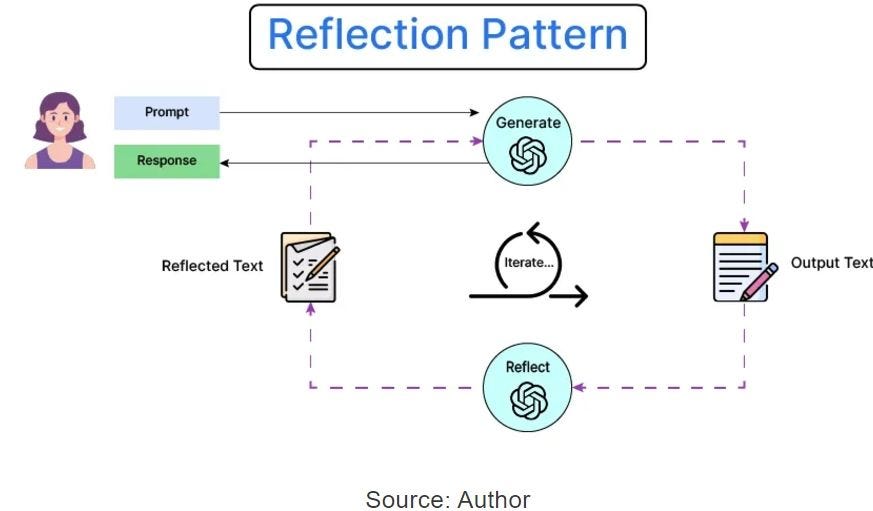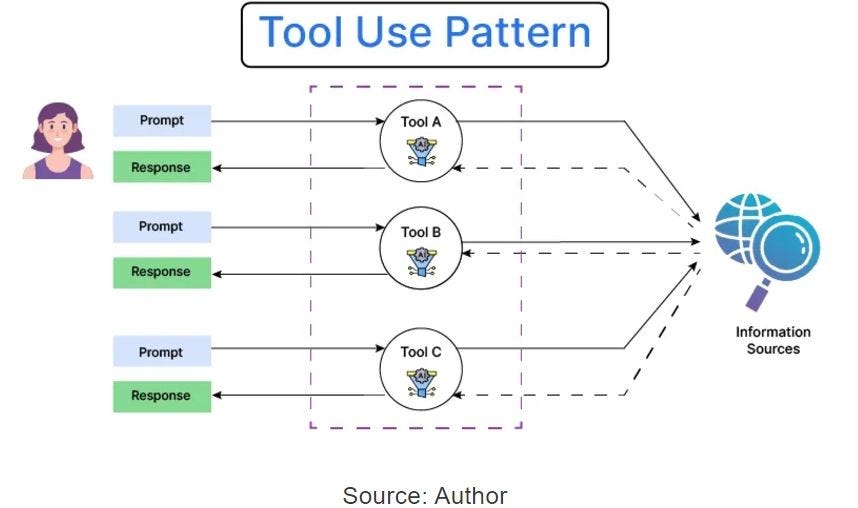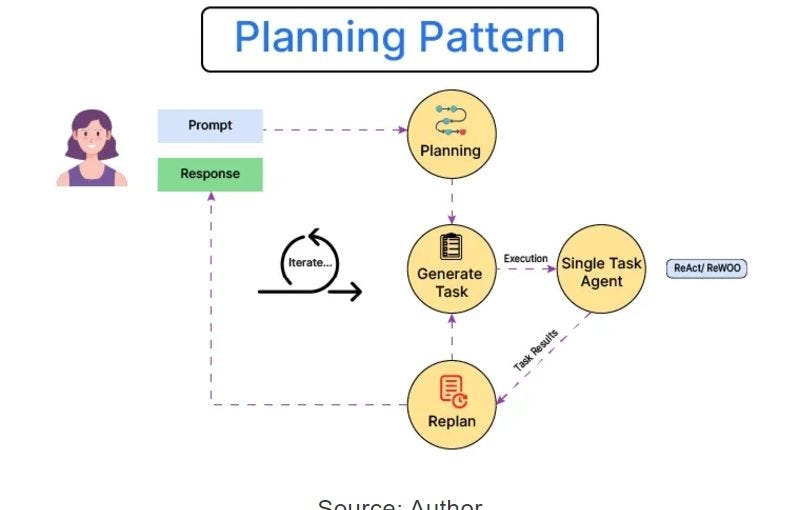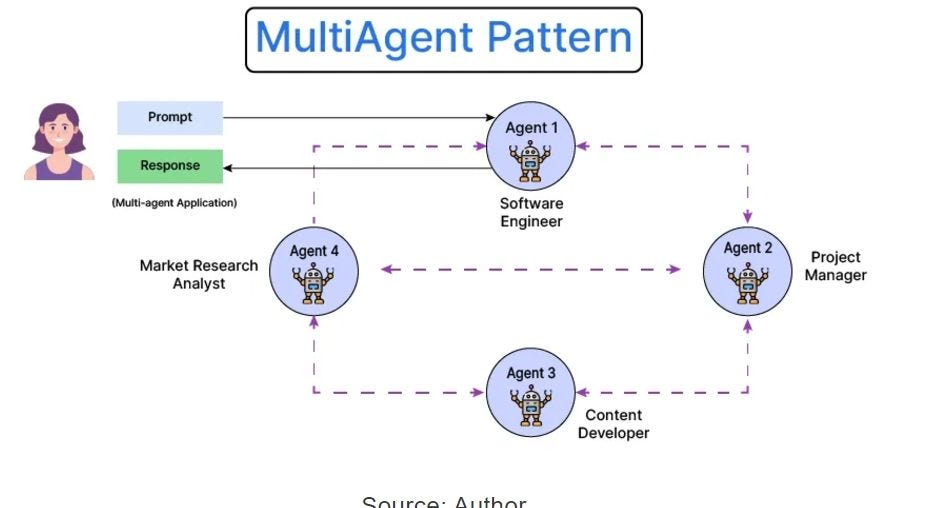Exploring Agentic AI Design Patterns
In the dynamic realm of artificial intelligence, particularly with large language models (LLMs), gaining insight into agentic AI design patterns is crucial for unlocking their full potential. These design patterns serve as frameworks that enable AI to function more independently and effectively, mirroring human-like problem-solving abilities. In this chapter, we will examine four essential agentic design patterns—Reflection, Tool Use, Planning, and Multi-Agent collaboration—and their significance in creating smarter, more adaptable AI systems.
Reflection Pattern: The Power of Self-Assessment
The Reflection Pattern plays a vital role in enhancing an AI’s ability to learn from its experiences. By allowing AI systems to critically evaluate their outputs, they can identify and correct mistakes, fill in knowledge gaps, and continuously improve through iterative processes. This reflective capability is particularly advantageous in tasks where precision is key, such as content creation and coding.
Source: https://www.analyticsvidhya.com/blog/2024/10/agentic-design-patterns/
One noteworthy approach within this pattern is Self-Reflective RAG (SELF-RAG), which bolsters the quality and factual accuracy of language models. By employing "reflection tokens," the AI assesses its own generation process, retrieving relevant information dynamically and critiquing its output. This self-reflective mechanism ensures that the results are not only accurate but also pertinent, leading to greater reliability. Educators and instructional designers can harness this pattern to develop AI tools that evolve and enhance user interactions over time, setting a high standard for excellence in educational contexts.
Tool Use Pattern: Expanding Capabilities Beyond Pre-Existing Knowledge
The Tool Use Pattern signifies a transformative shift in AI capabilities. By enabling AI to engage with external resources and tools, it moves beyond the constraints of its built-in knowledge. This interaction allows AI systems to access vast databases, perform web searches, or execute programming tasks, thereby managing complex challenges with ease.
Source: https://www.analyticsvidhya.com/blog/2024/10/agentic-design-patterns/
Envision an AI assistant in a classroom that can tap into various educational databases, providing real-time information during discussions. Implementing this pattern makes educational tools more versatile, offering learners tailored support based on the latest data rather than solely on static content. This adaptive use of resources enriches the learning journey, preparing students for a world where information is constantly evolving and readily available.
Planning Pattern: Strategic Roadmapping for Success
Effective planning is a hallmark of robust problem-solving, and the Planning Pattern equips AI models with the tools to break down complex tasks into manageable steps. This method creates a clear roadmap for achieving goals, enhancing efficiency in task execution.
Source: https://www.analyticsvidhya.com/blog/2024/10/agentic-design-patterns/
With variations like ReAct (Reasoning and Acting) and ReWOO (Reasoning With Open Ontology), the Planning Pattern enables AI to alternate between reasoning and task performance while drawing on broader contextual information. In educational settings, this could translate into AI systems that assist students in managing projects by structuring their assignments and adapting strategies based on feedback and outcomes. Empowering learners in this way not only fosters autonomy but also promotes success.
Multi-Agent Pattern: Collaboration for Comprehensive Solutions
The Multi-Agent Pattern introduces a collaborative approach, deploying multiple AI agents, each designated for specific roles, to tackle different aspects of a task. This teamwork allows agents to manage subtasks independently while communicating and working towards a shared goal.
Source: https://www.analyticsvidhya.com/blog/2024/10/agentic-design-patterns/
Various types of multi-agent structures exist: collaborative agents, supervised agents, and hierarchical teams. In an educational context, collaborative agents can come together to facilitate group projects, bringing diverse expertise to the table. Supervised agents can oversee these collaborations, ensuring quality and coherence. Hierarchical teams can be employed to handle larger educational initiatives, promoting efficient decision-making across levels. Adopting this pattern can significantly enrich classroom experiences, fostering a more inclusive and comprehensive learning environment.
Conclusion: The Future of AI Design Patterns
Agentic AI design patterns reveal the immense potential for making AI models, especially LLMs, more autonomous and effective. While models like GPT-3.5 and GPT-4 excel at performing tasks without prior examples, their accuracy and effectiveness greatly increase when leveraging iterative, agentic workflows. This multifaceted approach empowers models to dissect tasks, self-evaluate, utilise external tools, plan strategically, and collaborate with other agents, thus enhancing their overall problem-solving capabilities.
Looking forward, the evolution of AI will depend not only on increasing model sizes but also on developing adaptive and strategic workflows. For adult educators and instructional designers, embracing these agentic design patterns offers the opportunity to create innovative educational tools and practices that can transform learning experiences in profound ways.
Related Resources
"Artificial Intelligence for Educators: A Practical Guide to Learning with AI" - An insightful resource aimed at helping educators grasp and implement AI technologies effectively in their teaching practices.
"Designing Intelligent Agents: Advanced Techniques for AI Development" - This book offers valuable insights into various AI design patterns and methodologies that enhance the autonomy and capability of intelligent systems.
"Collaboration in AI: Harnessing the Power of Multi-Agent Systems" - A deep dive into the dynamics of multi-agent systems in AI and their practical applications in educational settings, promoting teamwork and collaborative learning.
Agentic Design Patterns: Enhancing AI Autonomy - An informative article exploring the fundamentals of agentic design patterns and their applications in creating autonomous AI systems.





